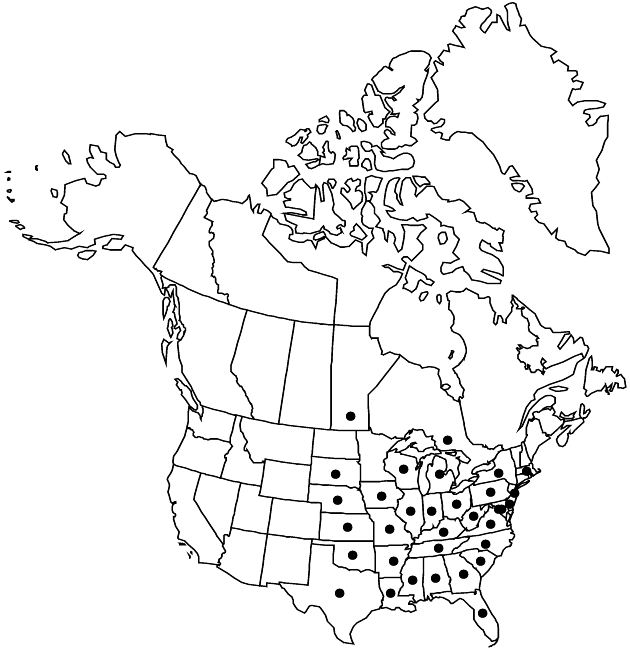Difference between revisions of "Lactuca floridana"
Fruct. Sem. Pl. 2: 362. 1791.
FNA>Volume Importer |
FNA>Volume Importer |
||
| Line 10: | Line 10: | ||
|name=Sonchus floridanus | |name=Sonchus floridanus | ||
|authority=Linnaeus | |authority=Linnaeus | ||
| + | |rank=species | ||
|publication_title=Sp. Pl. | |publication_title=Sp. Pl. | ||
|publication_place=2: 794. 1753 | |publication_place=2: 794. 1753 | ||
| Line 16: | Line 17: | ||
|name=Lactuca floridana var. villosa | |name=Lactuca floridana var. villosa | ||
|authority=(Jacquin) Cronquist | |authority=(Jacquin) Cronquist | ||
| + | |rank=variety | ||
}} {{Treatment/ID/Synonym | }} {{Treatment/ID/Synonym | ||
|name=Mulgedium floridanum | |name=Mulgedium floridanum | ||
| − | |authority= | + | |authority= |
| + | |rank=species | ||
}} | }} | ||
|hierarchy=Asteraceae;Asteraceae tribe Cichorieae;Lactuca;Lactuca floridana | |hierarchy=Asteraceae;Asteraceae tribe Cichorieae;Lactuca;Lactuca floridana | ||
| Line 43: | Line 46: | ||
-->{{#Taxon: | -->{{#Taxon: | ||
name=Lactuca floridana | name=Lactuca floridana | ||
| − | |||
|authority=(Linnaeus) Gaertner | |authority=(Linnaeus) Gaertner | ||
|rank=species | |rank=species | ||
| Line 58: | Line 60: | ||
|publication year=1791 | |publication year=1791 | ||
|special status= | |special status= | ||
| − | |source xml=https://jpend@bitbucket.org/aafc-mbb/fna-data-curation.git/src/ | + | |source xml=https://jpend@bitbucket.org/aafc-mbb/fna-data-curation.git/src/eaa6e58056e40c9ef614d8f47aea294977a1a5e9/coarse_grained_fna_xml/V19-20-21/V19_349.xml |
|tribe=Asteraceae tribe Cichorieae | |tribe=Asteraceae tribe Cichorieae | ||
|genus=Lactuca | |genus=Lactuca | ||
Revision as of 19:18, 16 December 2019
Annuals or biennials, 25–150(–200+) cm. Leaves on proximal 2/3–3/4 of each stem; blades of undivided cauline leaves oblong, ovate, or elliptic, margins entire or denticulate, midribs sometimes sparsely pilose. Heads in (± pyramidal) paniculiform arrays. Involucres (8–)10–12+ mm. Phyllaries usually reflexed in fruit. Florets 10–15(–25+); corollas bluish or whitish, seldom deliquescent. Cypselae: bodies brown (often mottled), ± compressed-lanceoloid to -fusiform, 4–5 mm, beaks ± stout, 0.1–0.5(–1) mm, faces 5–6-nerved; pappi white, 4–5 mm. 2n = 34.
Phenology: Flowering (Jun–)Aug–Sep(–Oct).
Habitat: Moist to wet places, margins of thickets and woods
Elevation: 10–200 m
Distribution

Man., Ont., Ala., Ark., Del., D.C., Fla., Ga., Ill., Ind., Iowa, Kans., Ky., La., Md., Mass., Mich., Miss., Mo., Nebr., N.J., N.Y., N.C., Ohio, Okla., Pa., S.C., S.Dak., Tenn., Tex., Va., W.Va., Wis.
Discussion
The “double” pappi of Lactuca floridana (and L. biennis) are very similar to pappi found in species assigned to Cicerbita Wallroth (ca. 35 spp., Europe, Asia, Africa). Return of the species to Cicerbita as C. floridana (Linnaeus) Wallroth may have merit.
Selected References
None.